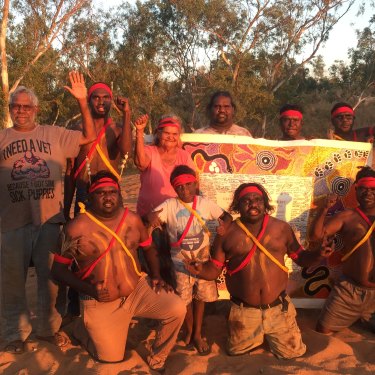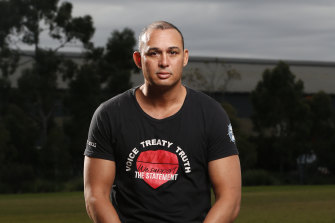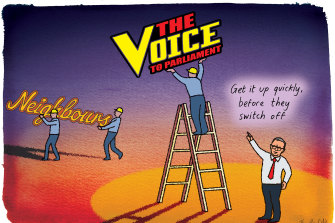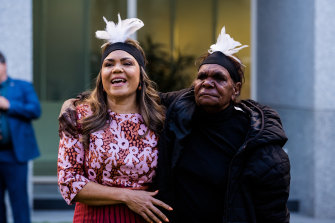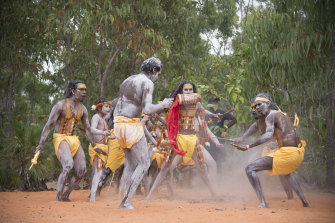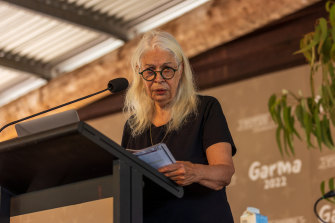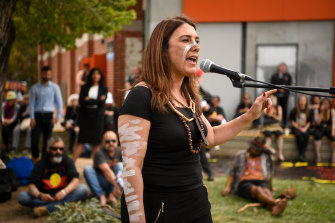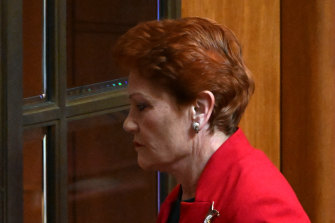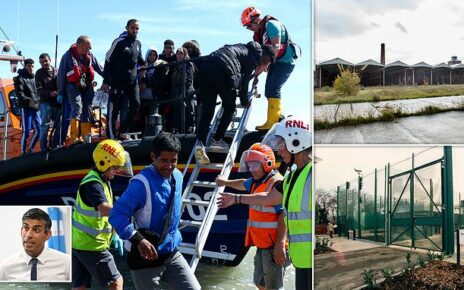By Jack Latimore
Thomas Mayor (far left) takes the Uluru Statement canvas to the Yule River Bush meeting in the Pilbara.
For 18 months, Torres Strait Islander man Thomas Mayor toured Australia to build support for a First Nations Voice enshrined in the Constitution.
Between August 2017 and March 2019 he lugged around the country the original canvas on which over 250 people had signed the 12-paragraph Uluru Statement From the Heart, talking up Voice, Truth and Treaty, and then talking some more.
As Mayor later wrote for his 2019 book, Finding the Heart of the Nation, the eloquent statement brought together Indigenous people “from all points of the southern sky … [and] was forged after from more than two centuries of hardship and struggle” with the difficult task of determining how to reform the nation.
“It gives hope to a nation borne from many nations that we may find our collective heart,” he added.
Thomas Mayor helped write the Uluru Statement from The Heart then took it on the road.Credit:Getty Images
After five years watching Australians engage and embrace the idea of a Voice and the Uluru Statement, Mayor is optimistic. He believes there is enough goodwill from middle Australia to carry a “yes” vote at a future referendum on an Indigenous Voice to parliament.
“The difference will be how much we who support it believe in ourselves and each other,” Mayor said.
But the way the debate has shaped in the first sitting week of the new parliament must shake his confidence. Referendums in Australia require almost universal agreement to have any chance of success. Labor proposes to hold the referendum on May 27 next year; the 56th anniversary of the 1967 referendum that allowed the Commonwealth to make legislation for Aboriginal people and include them in the national census.
Illustration: Jim PavlidisCredit:Jim Pavlidis
If the government expects this referendum will achieve the widespread support of 1967 (91 per cent “yes” vote), it might be disappointed. In her maiden speech on Wednesday, the new conservative Northern Territory senator Jacinta Nampijinpa Price, a Warlpiri-Celtic woman, labelled the Indigenous Voice a symbolic gesture that could divide black and white Australia. She later told The Age and Sydney Morning Herald she would actively campaign against the Voice inside the Coalition party room.
Patricia Turner, an Arrernte-Gurdanji woman, who heads up the Coalition of Peaks – the body working with the Council of Australian Governments to Close The Gap – strongly suggested the goals of her project were more urgent than the Voice. And Greens senator for Victoria, Lidia Thorpe, a Djab Wurrung Gunnai-Gunditjmara woman, this week said she had “many activists around the country” preparing campaigns against a constitutionally enshrined Indigenous Voice.
“They [the activists] are going to go hard,” Thorpe told The Australian.
These are the Aboriginal opponents.
Many on Peter Dutton’s opposition benches have also started expressing their disquiet, though the party itself is yet to reach a position. Under Scott Morrison, the Coalition was pushing for a “co-designed” Voice to government, through legislation, as opposed to the constitutionally enshrined model forecast by the Uluru Statement.
Jacinta Nampijinpa Price begins her career as a senator this week, supported by her grandmother Tess Napaljarri Ross.Credit:James Brickwood
In his speech at Gulkala in Eastern Arnhem Land on Saturday, Anthony Albanese will outline his road map for the Voice.
Perhaps he hopes that, like Paul Keating’s Redfern speech or Kevin Rudd’s national apology, his address will install him in the history books.
His Indigenous Australians Minister Linda Burney sounded as confident as Mayor when she told The Age: “I believe Australians are ready to take the next step. There is already incredible support in the community for this to happen”.
But there are enough early signs to suggest this is naive optimism.
Indigenous affairs minister Linda Burney believes Australians are ready to “take the next step” by voting for an Indigenous Voice to parliament.Credit:Brook Mitchell
Avoiding death by detail
A key debate about the referendum will focus on how much detail should be contained in the question put to Australians. Will the Voice referendum, like the failed republic referendum of 1999, propose a particular model, which opens the danger of people voting against the specifics, even if they support the general concept?
Or should it be a simple yes/no question – Voice or no Voice? – which would invite the accusation that those who framed it are keeping people in the dark?
A follow-up question will be to ask how much of the Voice needs to be enshrined in the Constitution?
Earlier this week, Labor senator Pat Dodson promised to produce an “exposure document” on the Voice by Christmas, to set out key elements of the government’s proposed model.
Sources familiar with the process but not authorised to speak publicly say this could simply involve outlining “design principles” for a future referendum, but not the wording of the proposal itself.
“It’s natural for people to want to know something about what this is going to look like,” Dodson said this week, before adding it would be a “terrible” idea to enshrine the entire model of the Voice in the Constitution.
Elsewhere, Burney said she did not believe the Voice model needed to be finalised before Australians decided whether it should be constitutionally enshrined.
In a column for The Australian this week, constitutional lawyer Greg Craven argued for greater detail, saying “Australia needed a blueprint, not a newspaper ad” from Voice proponents.
Mayor’s view is simply that the Voice will be a guaranteed First Nations representative body, similar in structure to many business associations or unions.
He says the simple approach should extend to the framing of the referendum.
“The model of the Voice is not what the referendum is about, it is about ensuring that there will always be a First Nations Voice in the centre of decision-making, and that First Nations people are recognised and respected for our sovereignty that was never ceded or extinguished,” he says.
Finding the right Voice
At the Garma Festival on Saturday, the prime minister will advocate for a clear and simple referendum proposition, as soon as possible.
“I believe the best way to seize the momentum is by settling – as soon as possible –
on the referendum question that will be put to the people of Australia,” Albanese will say.
“I would like us to present the Australian people with the clearest possible referendum question. We should consider asking our fellow Australians something as simple as:
‘Do you support an alteration to the Constitution that establishes an Aboriginal and Torres Strait Islander Voice?’. A straightforward proposition. A simple principle.”
A ceremonial dance marks the start of the Garma Festival in northeast Arnhem Land on Friday.Credit:AAP
Albanese will pitch the Voice as an “unflinching source of advice and accountability”, but stress it won’t be a third chamber of parliament with veto rights over legislation.
His speech will make three basic propositions: that there should be a Voice; that it should advise parliament and executive government on matters that affect First Nations people; and, that the new body should remain under the power of the parliament.
That matches the 2021 final report of the Indigenous Voice co-design process, which was guided by 115 community consultations and feedback from more than 10,000 First Nations people and organisations.
Chaired by Professor Tom Calma and Professor Marcia Langton for the National Indigenous Australians Agency, the process was overseen by former Coalition minister for Indigenous Australians Ken Wyatt.
It proposed a 24-member national body to provide advice to government and parliament on legislation affecting Aboriginal and Torres Strait Islander people. Two representatives would come from each state and territory; two from the Torres Strait Islands; and an additional five remote Aboriginal community residents – one each from Western Australia, the Northern Territory, Queensland, NSW and South Australia. Parliamentarians who did not submit relevant legislative bills to the Voice for consideration would be obligated to explain their decision in the lower chamber.
Professor Marcia Langton, who has helped craft a proposed model for the Indigenous Voice, speaks at the Garma Festival at Gulkula on Friday.Credit:Tamati Smith, Getty Images
Calma says it’s the right mix; the ability to influence decisions that affect First Nations people, without the power to veto legislation, and likens the proposed Voice to existing committees that scrutinise bills for duplication and advise parliament on potential human rights breaches.
On Friday, Langton urged those decrying the lack of detail to study the 270-plus page report she and Calma delivered as co-chairs last year, as well as up to a dozen other reports various inquiries and commissions have delivered about the Voice proposal in the past 10 years.
She told ABC radio she was starting to think those complaining they hadn’t been provided with enough detail were “mischief making” and “sowing confusion” with their claims of ignorance.
What we know about a ‘no’ campaign?
Mayor, who now also sits on the Advisory Group for the From The Heart campaign alongside high profile Indigenous constitutional reform advocates Noel Pearson, Tanya Hosch and Karen Mundine, says polling shows strong support for the Voice.
“I don’t believe there will be much of a ‘no’ campaign, as compared to the amounts of organisations and key individuals that support a ‘yes’ vote,” Mayor says.
“What I am concerned about … is if those who will vote ‘yes’ … remain quiet, [by] sitting on the fence, [they’ll be] apathetically letting this once-in-generations opportunity pass us by.”
In the past, the government has typically, but not always, funded both “yes” and “no” campaigns at constitutional referendums. In 1967, the lack of a single vote against the proposal by parliamentarians meant the no campaign did not exist, explains Professor George Williams, a constitutional expert at the University of NSW. So, for that referendum, there was nothing speaking against the proposal included in the Yes/No pamphlet distributed to voters.
Williams says the Referendum Machinery Act prevents the government funding campaigns until a proposal is settled upon. But once that happens it can fund multiple “yes” or “no” cases as it wishes, so long as it is authorised by both houses of parliament as happened at the 1999 referendum when the Howard government funded two campaigns against the proposal for a republic.
Rather than campaign funding, Williams is more concerned that Australia’s referendum rules have not kept pace with the modern age, particularly social media, which did not exist in 1999.
You get one shot
Judging by the debate when parliament opened this week, it’s likely there will be a “no” campaign, whether funded by the Commonwealth or not.
The opposition started as far back as 2013, but intensified the moment a Voice was proposed in 2017. Though the Uluru Statement was framed as an invitation for Australians to walk with First Nations people, the prime minister of the day, Malcolm Turnbull, rejected the Voice, saying it was neither “desirable or capable of winning acceptance at referendum” as it “would inevitably become seen as a third chamber of parliament”.
From the beginning, the referendum council’s national conference, along with its 13 regional dialogues that preceded the meeting at Uluru, was criticised by some Indigenous rights activists as being overly curated and unrepresentative. As we saw this week, the process and the Uluru Statement remains contentious among First Nations groups, Indigenous politicians, and Aboriginal rights and sovereignty activists.
Victorian Greens senator Lidia Thorpe said this week she has many activists ready to campaign against an Indigenous Voice to parliament. Credit:Justin McManus
On the hard left, Thorpe, the firebrand Greens senator, is vocal about prioritising a Treaty and Truth-telling process ahead of an Indigenous Voice to parliament.
She was part of a group of about 20 delegates that walked out of the Uluru national dialogue in 2017, saying the conference was “a one-way conversation”.
“Every time we try and raise an issue our voices are silenced. They are not looking at any alternative options other than the Noel Pearson road map,” said veteran activist and Wiradjuri elder, Aunty Jenny Munro at the time.
Although Greens leader Adam Bandt assured voters before the election his party would not block an Indigenous Voice to parliament, there is a view Thorpe and fellow senator Dorinda Cox are influencing a recalibration of that position.
Munro, meanwhile, maintains her views today, and says she would be the first to launch a “no” campaign.
One Nation leader Pauline Hanson walks out of the Senate during the acknowledgment of Country this week.Credit:AAP
At the other extreme, One Nation leader Senator Pauline Hanson says a Voice would effectively create apartheid in Australia, giving a minority of Australians more political franchise than the majority, based on race.
The Voice, she said earlier this month, is “divisive, unfair and unjust” because “one adult, one vote is the only democratic system that is free and fair.”
If the referendum doesn’t get up, there’s no pot of gold at the other end. Treaty will not be sitting there waiting
Another argument is that, with 26 MPs across all Australian parliaments now identifying as Indigenous – about 3.1 per cent – including 11 Indigenous MPs in Canberra, Aboriginal Australians are already appropriately represented.
Proponents of the Voice say this is a red herring: those MPs and senators represent their electorates, as they should, not the interests and special rights of First Nations which never ceded their Sovereign rights to Country.
Bundjalung-Gumbaynggirr-Yuin man, Nyunggai Warren Mundine – representing the Centre for Independent Studies – said he would oppose the Voice because Australia had a “very strong liberal democracy and Indigenous people have achieved equality within that framework”. This echoes the “if it ain’t broke don’t fix it” argument made by Australians for a Constitutional Monarchy at the Republic referendum more than 20 years ago.
On the other hand, long-time Aboriginal activist, palawa man Michael Mansell, founder of the Aboriginal Provisional Government, describes the Voice to parliament as “assimilationist”. He wants seats reserved in the Senate for Indigenous representatives.
Voice proponent Professor Megan Davis, a Cobble Cobble woman and a key figure behind the Uluru Statement, defends the concept and the dialogue process from which it emerged, arguing this is Australia’s one shot to do it right.
“The Voice has been developed in plain sight. There’s no chicanery here, no trickery. … It has mob input and shape from 13 dialogues and a national meeting,” Davis says.
“If the referendum doesn’t get up, there’s no pot of gold at the other end. Treaty will not be sitting there waiting. It doesn’t work that way.”
The Morning Edition newsletter is our guide to the day’s most important and interesting stories, analysis and insights. Sign up here.
Most Viewed in National
Source: Read Full Article
